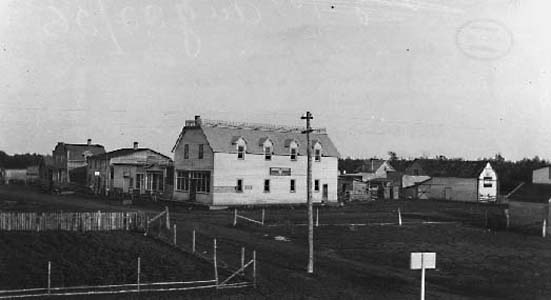Search | Image Archive | Reference | Communities | POV | Lesson Plans | Credits
 The land around Fisher Branch had been granted to Icelanders as a part of the Icelandic Reserve in 1875. Most it was swampy, however, and the New Icelanders never occupied it, choosing to settle instead in communities like Gimli and Arborg along the east margin of the reserve.
The land around Fisher Branch had been granted to Icelanders as a part of the Icelandic Reserve in 1875. Most it was swampy, however, and the New Icelanders never occupied it, choosing to settle instead in communities like Gimli and Arborg along the east margin of the reserve.
Prior to 1900, there had been some aboriginal and métis settlement in the area, as well as some commercial logging. By the turn of the century, the area had been trapped-out, and most aboriginals settled further to the north, mainly on the Fisher River Reserve, where the land would still support traditional lifestyles. Some had moved south to St. Peter's where they took part in experiments in European-style agriculture.
Many of the métis remained, practising a kind of mixed farming that included field crops, vegetables and livestock, supplemented with money earned on the trap line or through the sale of firewood. By the end of the first decade of the twentieth century, however, they found themselves to be a definite minority in the area.
A number of homesteaders started to arrive in the region after 1903. Land prices in the southern part of the province had escalated beyond the reach of many new immigrants, but in the Interlake, land was still available for $10 for a 160 acre quarter section.
Many of these new arrivals were from Poland, Quebec or the French-speaking parts of Minnesota, but the largest group were from the Ukraine. Many Ukrainian immigrants had been driven from their Europe by a desperate shortage of land. In 1896, the Dominion government, which had a strong interest in seeing all available land put under plough, began intensively recruiting immigrants in the Ukraine. The then Minister of the Interior, Clifford Sifton, was said too have had a special affinity for eastern European farmers, and with the co-operation of philanthropic organizations overseas, initiated a process by which many Ukrainians settled on the prairies.
Hampered by heavy forest, marsh and poorly-drained, rocky soil, farms in the Fisher Branch area were slow to grow and were never as prosperous as those to the south, but the community grew steadily through the first two decades of the twentieth century. The railway came in 1914, eliminated the need for the full-day ox-cart trek to Arborg, and a small commercial centre emerged.
TimeLinks Characters: Thomas Golas lives in Fisher Branch.
Page revised: 29 August 2009